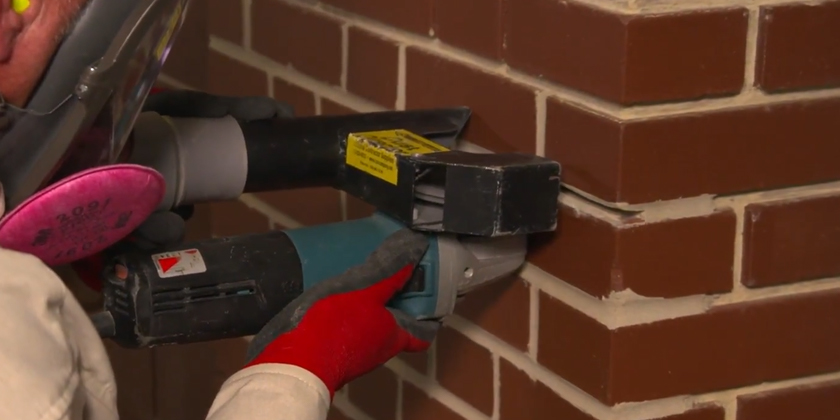Handheld Grinders for Mortar Removal & Respirable Silica
The Occupational Safety and Health Administration requires employers to limit workers exposure to respirable crystalline silica on the job. Hence, the video below and the chart on this page show the standards and requirements necessary for tasks performed using handheld grinders for mortar removal. Using these standards helps you with handheld grinders for tuckpointing and exposure control.
When used properly these methods effectively limit workers’ exposure to potentially harmful silica dust. The video below shows the method for reducing exposure while using a handheld grinders for tuckpointing. However, the same principles apply to any power tools that generate silica dust. In fact, many tools used for cutting and grinding various stone products require safety methods for reducing dust. This is especially true of high dust producing equipment.
Operating Handhled Grinders Safely
In order to comply with the table below, dust collection systems and techniques must be used in the immediate work environment to effectively remove dust form the area. Dust collection and shroud systems effectively remove dust as it is generated by grinding. Additionally, the dust collector must remvoe dust at an approved rate in line with the length of time the worker is performing the grinding.
The dust collector must also have a filter that with 99% or greater efficiency and a cyclonic pre-separator or filter cleaning mechanism. Additionally, the cyclonic pre-separator and filter cleaning mechanisms prevent debris from building up on the filter and hindering the dust collector’s effectiveness.
Operators Checklist
Operators regularly check the machine’s condition. They also perform regular maintenance to grinders to keep them in good working order. Hence, maintenance tasks often recommended by grinders and dust collector manufacturers often include the following:
- Clean and replace filters as needed.
- Do not overfill the waste container.
- Follow a specific maintenance schedule.
- Regularly check the dust collection system for signs of damage.
- Make sure the hose connecting the tool to the vacuum is intact and without kinks or tight bends.
Operators regularly perform these cleaning and maintenance tasks. As a result, this ensures that the equipment performs at it best.
Tuckpointing In An Enclosed Area
Using a handheld grinder for tuckpointing indoors or in an enclosed area requires workers to have an exhaust method for removing dust from the work area. Furthermore, having a way to remove silica dust from the work area minimizes the accumulation of visible airborne dust. As a result, this safety requirement helps to reduce the risk of silicosis from exposure to respirable crystalline silica dust.
| Specified Exposure Control Methods When Working With Materials Containing Crystalline Silica | |||
|---|---|---|---|
| Equipment / Task | Engineering and Work Practice Control Methods | Required Respiratory Protection and Minimum Assigned Protection Factor (APF) | |
| ≥ 4 hours/shift | > 4 hours/shift | ||
| (xi) Handheld grinders for mortar removal (i.e., tuckpointing) | Usa grinder equipped with commercially available shroud and dust collection system
Operate and maintain tool in accordance with manufacturer’s instructions to minimize dust emissions Dust collector must provide 25 cubic feet per minute (cfm) or gteater of airflow per inch of wheel diameter and have a dilter with 99% or greater efficiency and a cyclonic pre-separator or filter-cleaning mechanism. |
APF 10 | APF 25 |

